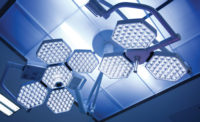When aging, outdated systems at Hardin Medical Center (HMC) provided inadequate cooling and insufficient humidity control, hospital administrators undertook a number of upgrades. The Savannah, TN, medical facility, built in 1952, sought to improve the environment of care — especially in its labor and delivery area — to increase patient, physician, and staff comfort while also helping to reduce the chance of medical errors and infection. HMC also wished to increase the efficiency of its systems in order to combat rising operational and energy costs.
Prior to undertaking the improvements, leaders at HMC completed an environment of care study to identify ways to increase patient comfort, physician, and staff satisfaction and the hospital’s bottom line. They also used building information modeling to create an energy model of the entire facility, which was used to evaluate various energy conservation measures. Based on the results of these two evaluations, leaders identified upgrades that would best meet their needs.
Administrators at HMC report that infrastructure improvements to the healthcare facility have reduced annual energy and operational costs by more than 30% while increasing patient comfort and physician and staff satisfaction. The hospital also received an $11,500 rebate from the Tennessee Valley Authority (TVA) for reducing its load on the electrical grid.
The energy savings identified proved significant enough to cover the cost of a HVAC system to provide reliable temperature and humidity control for the labor and delivery area.
“We’re pleased that we can provide a more comfortable environment for patients and a more satisfying workplace for physicians and staff,” said Nick Lewis, chief executive officer at HMC. “It’s even better that the improvements generate significant energy and operational savings each year, and that we were able to fund them through a performance contract without any capital outlay.”
In recognition of the hospital’s commitment to energy, operational efficiency, and sustainability, Trane recently presented the hospital with its Energy Efficiency Leader Award.
HMC funded the improvements with a performance contract, which allowed the health care facility to use future energy and operational savings to finance the infrastructure improvements up front. Performance contracting is a funding option that provides measurable business results to support strategic objectives. The performance contract allowed the healthcare facility to leverage future energy and operational savings to finance the infrastructure improvements without upfront capital.
To improve energy efficiency throughout the facility, an HVAC system was added to serve the labor and delivery area, and the boiler plant was replaced and enhanced. The boiler plant now consists of two domestic hot water boilers, two condensing boilers, and one non-condensing boiler to provide the needed capacity and redundancy. A chilled water AHU was installed on the low roof outside the labor and delivery operating rooms. Designed to address critical indoor air quality issues to improve comfort and aid in patient recovery, the air handler helps ensure optimal operating room temperatures and humidity levels while removing airborne contaminants and lower sound levels, providing a comfortable and healthy indoor environment.
To reduce energy consumption, 2,135 lighting fixtures at HMC were replaced with new high-efficiency T-8 lamps and ballasts; energy-efficient, compact fluorescent lamps are now used instead of incandescent lamps; and exit signs were retrofitted with new LED signs. To conserve water, more than 350 fixtures were retrofitted with low-flow plumbing systems, which meet or exceed Energy Act water use requirements.
The existing DDC system was expanded to manage operation of the hot water system, the AHU on the labor and delivery wing, and 12 VAV and two constant volume terminal units, as well as rooftop units serving the cafeteria, administration offices, and conference room. The new digital controls enable precise management of the health care facility environment while reducing energy and operational costs.
HMC facilities managers now use a web-based systems integration solution that provides an online, enterprise-wide view of all the medical center buildings and systems. With access from any PC or mobile device on the network, facilities managers are able to conveniently handle daily operations, such as scheduling, alarm management, and troubleshooting; monitor and control energy use, lighting and HVAC to improve efficiency; and maintain optimal temperature, humidity, and carbon dioxide levels for a healthy environment.



